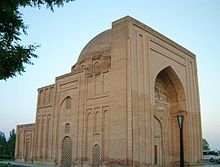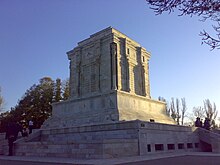Tus, Iran


Tus (Persian: طوس Tus or Tuws), also spelled as Tous, Toos or Tūs, is an ancient city in Razavi Khorasan Province in Iran near Mashhad. To the ancient Greeks, it was known as Susia (Ancient Greek: Σούσια). It was captured by Alexander the Great in 330 BCE. It was also known as Tusa.[1]
Tus was taken by the Umayyad caliph Abd al-Malik and remained under Umayyad control until 747, when a subordinate of Abu Muslim Khorasani defeated the Umayyad governor during the Abbasid Revolution.[2] In 809, the Abbasid Caliph Harun al-Rashid fell ill and died in Tus, on his way to solve the unrest in Khorasan.[3] His grave is located in the region.[4]
Tus was almost entirely destroyed by the Mongol conquests between 1220 and 1259.
The most famous person who has emerged from that area was the theologian, jurist, philosopher and mystic al-Ghazali. Another is the poet Ferdowsi, author of the Persian epic Shahnameh, whose mausoleum, built in 1934 in time for the millennium of his birth, dominates the town. Other notable residents of Tus include the early polymath Jābir ibn Hayyān; the poet Asadi Tusi; the powerful Seljuk vizier Nizam al-Mulk; the medieval polymath Nasir al-Din al-Tusi; and the prominent Twelver Shi'i Islamic scholar Abu Ja'far Tusi.
See also
- Al-Tusi - a descriptor used for individuals associated with Tus
- Tus citadel
References
- ^ Keall, E., M. Roaf, R. Talbert, T. Elliott, S. Gillies. "Places: 952108 (Tusa/Sousia)". Pleiades. Retrieved January 5, 2015.
{{cite web}}: CS1 maint: multiple names: authors list (link) - ^ Tus, V. Minorsky, The Encyclopaedia of Islam, Vol. X, ed. P.J. Bearman, T. Bianquis, C.E. Bosworth, E. van Donzel and W.P. Heinrichs, (Brill, 2000), 741.
- ^ The Court of the Caliphs by Hugh N Kennedy (ISBN 0 297 83000 7)
- ^ Hudud al-Alam translated by V. Minorsky (SBN 7189 -2-1 7)
External links
 Media related to Tus, Iran at Wikimedia Commons
Media related to Tus, Iran at Wikimedia Commons- Livius.org: Susia (Tus)
